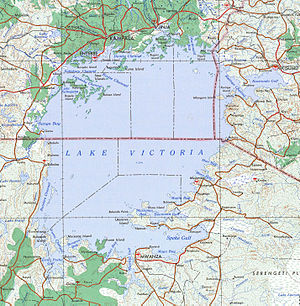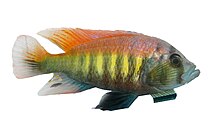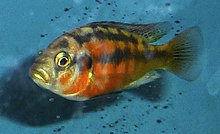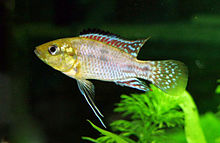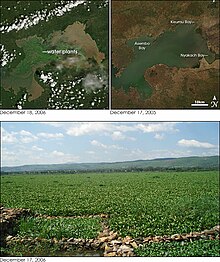Lake Victoria
| Lake Victoria | |
|---|---|

|
|
| Geographical location | Tanzania , Uganda and Kenya |
| Tributaries | Kagera Nile |
| Drain | Victoria Nile |
| Places on the shore |
Entebbe , Mwanza , Jinja , Kisumu |
| Data | |
| Coordinates | 1 ° 0 ′ S , 33 ° 0 ′ E |
| Altitude above sea level | 1135 m |
| surface | 68,870 km² |
| length | 337 km |
| width | 250 km |
| volume | 2,760 km³ |
| Maximum depth | 85 m |
| Middle deep | 40 m |
|
particularities |
largest lake in Africa, Beckensee , transformed natural lake |
The Victoria (also Victoria , Victoria Nyanza , formerly Ukerewesee) is located in East Africa and is part of the countries of Tanzania , Uganda and Kenya . It is the third largest lake (after the Caspian Sea and Lake Superior ) and the second largest freshwater lake in the world (after Lake Superior ). Lake Victoria is the largest lake in Africa and has a catchment area of 193,000 km². It has an area of 68,800 km², which roughly corresponds to the area of Bavaria or Ireland. In 2007, around 30 million people lived on its banks.
geography

The lake is located in the East African plateau. The area of the lake is shared by the states of Tanzania (49% of the lake area), Uganda (45%) and Kenya (6%). Its coastline has a length of 3450 km, of which 1750 km are in Tanzania, 1150 km in Uganda and 550 km in Kenya.
While Lake Victoria is fed by the Kagera Nile in the west , its outflow is in the north - this is the Victoria Nile (hence the lake is considered its source, but not the Nile source ). The largest island is Ukerewe with 560 km² in front of the south bank. Large stretches of its bank are lined with extensive papyrus swamps.
The region around Lake Victoria is relatively rainy: the average rainfall is given as 1015 millimeters per year. Lake Victoria receives 85% of its lake water from precipitation and 15% from tributaries (including the rivers Kagera, Nzoia , Sio and Yala ). Evaporation is high and corresponds to 85% of the water flowing out of the lake.
In terms of geological history, Lake Victoria is a very young lake, its age is estimated to be less than a million years. It dried out completely 14,700 years ago. It has an amazing biodiversity. The tributaries also include the Pindibo and Adabo (from Burundi) rivers.
Lake Victoria was rediscovered for the western world in 1858 by the British explorer John Hanning Speke and named after the then Queen of Great Britain , Victoria . In 1875 Sir Henry Morton Stanley traveled the lake in a ship, circling it once completely.
From a natural lake to a reservoir
The reservoir volume is 204.8 km³ and its total volume is 2760 km³. However, its former natural size was artificially increased by the construction of the Owen Falls Dam , which was completed in 1954 near Jinja on the Victoria Nile, so that the natural lake was flooded by the water from the resulting reservoir - called the "Victoria Reservoir" . Since then, the Owen and Ripon Falls , which had been exposed to the north of its former north bank, have also been flooded. According to various sources, the lake, whose water surface is 1134 meters above sea level, is a maximum of 81 meters or 85 meters and an average of 45 meters deep.
After Uganda put a second hydropower plant into operation in this area in 2002, the water level of the lake reached a record low in 2006, the last time it was measured 80 years ago.
Flora and fauna
In addition to the hippopotamus, there are over 250 species of fish in Lake Victoria . A large part of the biodiversity, the family of tilapia ( cichlid ), which, considering the relatively short period since the last drying of the lake, an extremely high diversity of species exhibited. This was therefore also a popular research object in evolutionary biology .
Fish species of Lake Victoria
Ecological disaster

In the 1960s, the Nile perch ( Lates niloticus ) was established as an allochthonous species in Lake Victoria in order to breed a commercially viable food fish . Its rapid increase was followed by the expected upswing in the export-oriented fish industry, but it ended in an unexpected disaster, since the Nile perch was partly responsible for the extinction of a large part of the cichlid species and ruined the local dried fish industry. Today the Nile perch is available as “Victoria perch” in the international fish trade. The film Darwin's Nightmare explores the background to this development . Through consistent consumption, however, the Nile perch was also severely decimated, which gives the other fish species more habitat.
Another problem is the water hyacinth , which does not occur naturally in Lake Victoria and which overgrows large areas today. In 1995 90% of the Ugandan coast was covered with this plant. Here, too, consistent use would contribute to ecological relief.
Due to the dense settlement on its banks, the lake has today with massive environmental problems such as B. Fight pollution and lack of oxygen. These phenomena of the crisis prompted the Global Nature Fund to declare Lake Victoria “Lake Victoria under threat in 2005”. According to an IUCN report published in 2018, one fifth of the 651 species examined in the Lake Victoria Basin are threatened with extinction. Three quarters of the 205 endemic species described are critically endangered.
Islands in Lake Victoria
Literature and film
- Tijs Goldschmidt : Darwin's dream lake. News from my research trip to Africa . CH Beck, Munich 1997, ISBN 3-406-42881-9
- Film: Darwin's Nightmare , director: Hubert Sauper, 2005 (also available on DVD). The multi-award-winning film documents the ecological and economic catastrophe on East African Lake Victoria caused by the release of the Nile perch.
See also
Web links

- Osienala - Friends of Lake Victoria - Kenyan environmental protection organization
- Informative site about Lake Victoria
- Official website of the film Darwin's Nightmare - documentary by Hubert Sauper (Austria) about Lake Victoria and the social, economic and political grievances there
- Protocol for Sustainable Development of Lake Victoria Basin , contract available in ECOLEX - the gateway to environmental law (English)
to ecology
- Threatened Lake of 2005: Lake Victoria in Kenya, Tanzania and Uganda , Global Nature Fund
- Hypertrophy of the water hyacinth
- Uganda pulls plug on Lake Victoria , New Scientist , February 9, 2006
to fauna
- Cichlids in Lake Victoria - information and pictures
Individual evidence
- ↑ Database for Hydrological Time Series of Inland Waters (DAHITI) - Victoria, Lake , accessed April 20, 2017.
- ↑ Lars Wirkus, Volker Böge: Africa's international rivers and lakes. Status and experience in cross-border water management in Africa using selected examples. (PDF; 1.4 MB) German Development Institute, report, 2005 p. 29
- ^ "Uganda pulls plug on Lake Victoria" , New Scientist, February 9, 2006
- ↑ a b Fishbase : Species in Lake Victoria , on fishbase.de
- ↑ IUCN: Freshwater biodiversity in the Lake Victoria Basin , 2018, doi : 10.2305 / IUCN.CH.2018.RA.2.en .
- ↑ Eawag : IUCN report against threatened species extinction in Lake Victoria In: eawag.ch, May 9, 2018, accessed on August 1, 2018.
